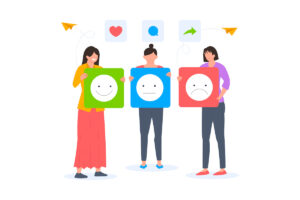Machines receiving data input are using literal empirical info to produce an outcome. Narrative input is about using context and human qualities to create understanding. If AI is to become a master storyteller then it must tackle narrative devices and break-down context.
Take a look at one of the best shows on television at the moment, WestWorld. It’s a rollicking ride through a sophisticated AI-inspired entertainment world made for humans and their every desire.
And let’s just say things go a little awry!
AI is a dream concept for sci-fi writers everywhere and you can bet your bottom dollar on seeing more and more pop culture references to utopian and, most likely, dystopian futures influenced by AI.
But instead of us turning AI into a highly engaging plot device in our books and tv shows – what about the idea that AI can actually enhance our storytelling potential in a marketing context and develop our ability to connect with an audience.

Storytelling has been the bedrock of human communication since time began. Stories are memorable.
What makes a good story? Creative thinking, emotion, empathy, awareness and context are just a few elements. It’s fair to say that AI is still pretty far behind humans in every storytelling respect.
A University of Pennsylvania study looked at hundreds of New York Times articles and found that the most frequently shared pieces were the most emotive stories that triggered a response, especially positive.
And similarly, the Computational Story Lab at the University of Vermont use AI to analyze novels to assess story structures and the elements used to construct stories. They find emotional arcs to map out building blocks.
[Tweet “Narrative input is about using context and human qualities to create understanding. #H2H”]
When AI can look at story and emotion arcs and see patterns, it can translate this into data. Instead of the art of storytelling, AI can help us with the science.
We can learn a lot from Kurt Vonnegut’s famous storytelling lecture about the use of arcs. He pinpoints Cinderella as using one of the most popular arcs: the protagonist in awful situation + improvement of situation + more drama + finally happily ever after. The rise-fall-rise pattern is an incredibly popular and effective device.
Applying the Science
IBM’s Watson is one of the most popular and sophisticated AI tools at the moment.
Two of its features Personality Insights and AlchemyLanguage make it possible to analyze content and text, for example from an influencer, and rate individuals across 52 personality traits. Brands can then connect with influencers that complement their audience personas and brand identity.
The AI-driven marketing platform, Influential, does just this and matches brand narrative with similar influencer narratives. The more aligned the narratives are, the better than an ad should perform. In 2016, they worked with Kia for a Super Bowl ad including Christopher Walken – it saw 30% higher engagement.
And not only can influencers and audiences team up with brands to create customer-driven narrative content, but machine learning models can enlist deep neural networks to analyze video content and tag similar audio and visual elements in emotional arcs.
This is exactly what’s happened at the Media Lab at the Massachusetts Institute of Technology. Performed across thousands of videos, machine learning models can identify dialogue, music or images to use in video content. Researchers concluded that “machines can view an untagged video and create an emotional arc for the story based on all of its audio and visual elements.”
In this instance, AI software could help video storytellers to highlight areas of their content that can include features to increase engagement. It’s up to storytellers and the context as to whether they want to enact AI advice, but it can allow them to look at their work more objectively and tighten their stories.
Humanistic AI
Instead of solely producing literal content like captioning, AI can become more humanistic if it can learn to understand how important descriptions and content can be in eliciting emotion.
While advertisers, screenwriters and content-creators need not worry about being replaced by AI, they can start to anticipate and prepare for AI collaborate that can improve the storytelling process. AI tools that can help humans select the best language, sentence structures, audio etc can enhance individuals’ ability to tell the best story and strengthen the overall narrative.
AI can help to give data-driven, scientific objective advice when it comes to partnering with brands, influencers, audiences and collaborators. Of course, what makes us human is our ability to weigh up information based on our very own preconceived ideas, biases and awareness. This will never change.
Humans’ ability to process context and use context to improve stories and provide meaning will be near possible to ever replicate with AI and this is something that we should celebrate and use to make narratives and emotional arcs even more unique.
Go Team Human!





